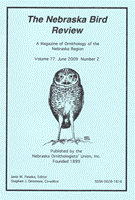Nebraska Ornithologists' Union

Nebraska Bird Review
Date of this Version
9-2014
Document Type
Article
Citation
Robbins, "Contact Zone of the Eastern and Western Marsh Wrens in Nebraska Revisited," from Nebraska Bird Review (September 2014) 82(3).
Abstract
Across the northern and coastal United States and southern central Canada the Marsh Wren (Cistothorus palustris) is a widespread breeder in cattail-dominated marshes. Although it has long been considered to be polytypic based on subtle plumage characters (Parkes 1959; Phillips 1986), it was not until Kroodsma (1989, 2005) demonstrated that there was a dramatic break in the primary (song) vocalization in the northern Great Plains that anyone suggested more than one species was involved. In 1986, as part of the delineation of the breeding distribution of both vocal types, Kroodsma (1988; see map therein) audio recorded wrens at nine localities in Nebraska. He determined that breeding eastern (Cistothorus p. palustris) birds are primarily restricted to the northeastern comer of the state, whereas westerns (C. p. paludicola) were found in the western two-thirds of the state north of the Platte River. He found no wrens in an approximate 100 km wide corridor, although at two localities he found both song types (hereafter referred to as Eastern and Western subspecies; based on upcoming genetic work it will soon be recommended that these be elevated to species level; K. Barker, Robbins et al.). Twenty-five years later, in early June 2011, I reassessed the distribution of breeding Marsh Wrens in Nebraska.


Comments
Copyright 2014 Nebraska Ornithologists’ Union. Used by permission.